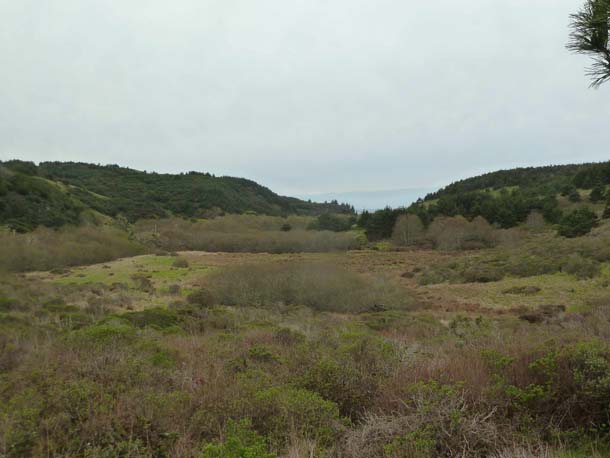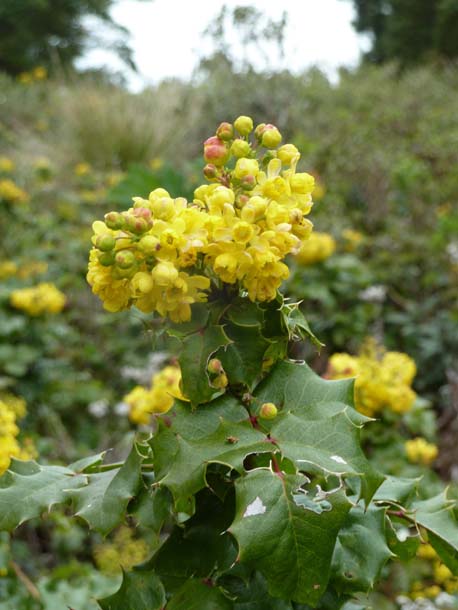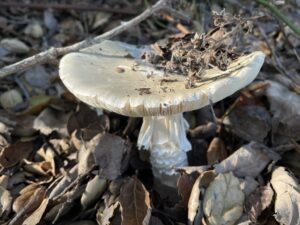Check out this and other hikes Jules has taken on this Google map. The most recent hike is in blue; others are in red.
Trail notes: A steep descent for the first 2.5 miles is moderately strenuous; the second half is a fairly easy stroll along the Muddy Hollow Trail back to the hostel. After a rain, Muddy Hollow Creek, though shallow and about ten feet wide, may need to be forded. Moderately strenuous. There are sweeping views of the outer Peninsula near the trailhead, but much of the path is narrow, passing through a dark forest of dense bishop pines that regenerated with a vengeance following the Mount Vision fire of October 1995. This trail is apparently favored by horse riders.
Conditions: High overcast, cool (50-55°F), wind variable, SW to NW, 5-10 MPH.
Starting at the end of the road up Mount Vision, atop Point Reyes Hill (elevation 1336′), the Bucklin Trail traces a small ridge that separates the Glenbrook Creek and Muddy Hollow Creek watersheds. Both creeks feed into Limantour Estero, which is only visible at the beginning and end of the trail. The bishop pines are dense through much of the mid-portion of the trail, and on this day the signs of wildlife were few, although mountain lion scat was quite common–four stool samples dropped in the middle of the trail along the trail’s upper reaches.
Douglas irises are now in full bloom, scattered along the trail wherever sunlight finds the ground. Their colors here are highly variable, seeming to span the length of the blue-indigo-violet end of the spectrum. (In Chinese painting, this unity of red and blue symbolizes the harmony of the universe, the yin and yang, a pleasant thought to ponder while admiring the iris’s dazzle.)
Likewise, the paintbrushes (Castilleja affinis) that trim the trail range through the orange-red spectrum–some are so crimson, they seem almost neon, others are as pale as a creamsicle.
In some shrubby slopes with western exposure in the Glenbrook Creek watershed, an attractive yellow-blooming shrub with prickly, holly-like leaves is in full bloom. This barberry, sometimes called Mahonia, is rather rare on the peninsula, but it has a range that extends through the coast ranges from Oregon south to San Diego.
-
Oregon grape, or shiny-leaved barberry (Berberis pinnata), with flowers in thick clusters (racemes) that will become blue berries after the flowering season. Photograph by Jules Evens.
This chilly afternoon there are few sounds–chickadees chattering, whispering pines, a gray squirrel gnawing a cone. The silence and the copious lion scat along the trail lend an eerie vibe to this shadowy trail. A pair of ravens monitors my progress as I move downslope, passing over every few minutes and uttering their throaty waaack, which sounds mocking to my ear, though I don’t take it too personally.
Just before the Bucklin Trail joins the Muddy Hollow Trail, the habitat transitions from pine forest to northern coastal scrub dominated by coyote brush (Baccharis pilularis). Although this area was charred to the ground during the Mount Vision fire, the coyote brush has fully recovered, growing thick and robust. Coyote brush sprouts out of a burly root crown that supports an extensive root system, an adaptation that allows this pioneering shrub to regenerate quickly after fire.

-
The Bucklin Trail intersects the Muddy Hollow Trail in a healthy stand of coastal scrub, or soft chaparral, in the foreground. In the distance, the riparian corridor that follows Muddy Hollow Creek, and Limantour Estero beyond. Photograph by Jules Evens.






